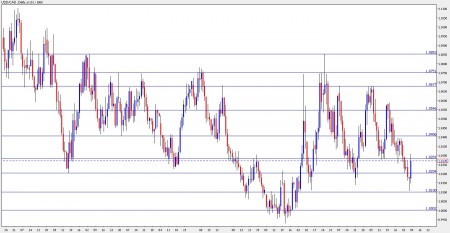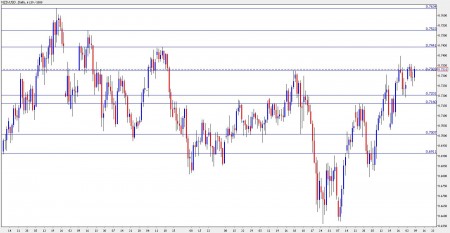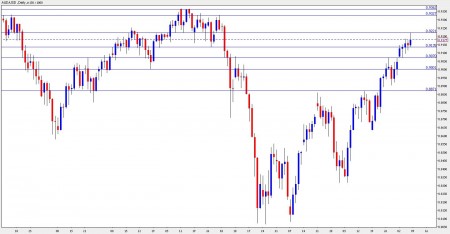Forex Crunch USD/CAD Outlook – August 9-13 |
- USD/CAD Outlook – August 9-13
- NZD/USD Outlook – August 9-13
- AUD/USD Outlook – August 9-13
- GBP/USD Outlook – August 9-13
| Posted: 07 Aug 2010 05:41 PM PDT A few interesting releases expect the loonie. Here’s an outlook for the Canadian events, and an updated technical analysis for USD/CAD. USD/CAD chart with support and resistance lines marked. Click to enlarge: Canada’s employment figures were very disappointing, and only a bigger disappointment in Non-Farm Payrolls from the US stopped USD/CAD from going higher. Let’s start:
USD/CAD Technical Analysis Tight range trading, between 1.0280 and 1.02 characterized the pair’s trading at the beginning of the week. It then broke below 1.02 and got close to the next support line of 1.01 before bouncing back up and closing at 1.0270. Most lines haven’t changed since last week’s outlook. USD/CAD is back to the 1.02 – 1.0280 range. Above 1.0280, the next line of resistance is 1.04. 1.04 was the long term support line of the 1.04 to 1.0750 range, and now works as a tough resistance line. Above, 1.0550 stopped the pair several times in the past, and is a minor resistance line. The next line of resistance is at 1.0680, which stubbornly held the pair in June and several times in July. Apart from being the long term top border of the range, 1.0750 was also tested in May. Above, 1.0850 was a swing high in 2009 and a swing high in May as well. Looking down under 1.0280, the 2009 low of 1.02 is the next support line. Note that it also worked as resistance after the pair hit parity in April. Lower, 1.01 is a minor line of resistance, and it's followed by the ultimate support line – parity. I remain bearish on USD/CAD. Despite the blow from the employment figures, the situation in Canada is still great, and the Federal Reserve could weaken the greenback, sending USD/CAD for another attempt on parity. Further reading:
Want to see what other traders are doing in real accounts? Check out Currensee. It's free.. |
| Posted: 07 Aug 2010 02:00 PM PDT Retail sales and other figures will shape the direction of the kiwi in the upcoming week. Here’s an outlook for the events that will move the New Zealand dollar, and an updated technical analysis for NZD/USD. NZD/USD chart with support and resistance lines marked. Click to enlarge: The kiwi was hurt by the disappointing employment figures, that showed a worrying leap of the unemployment rate to 6.8%. This erased some of the kiwi’s gains. Will we see positive numbers this time? Let’s start:
NZD/USD Technical Analysis The kiwi managed to rise above 0.7325 which it flirted with in the previous week but struggled to hold on to it. Employment data in New Zealand sent it down in the middle of the week, before American employment data on Friday helped it close at 0.7330, just above this resistance line. Note that some lines were modified since last week’s outlook. If 0.7325 holds this time, the road is open towards the next line of resistance – 0.7440 – the stubborn top at the beginning of the week. Higher, November’s peak of 0.7523 provides the next resistance line, and it’s followed by 0.7634, a peak in October. The next line of resistance comes from the era before the global crisis – July 2008. 0.7760 was a resistance line back then, and was a support line beforehand. Looking down below 0.7325, the round number of 0.72 provides strong support for the kiwi. The next support line is quite close – 0.7160 which capped the pair in June. The next round number of 0.70 serves as further support. It’s followed by 0.6910 which capped the pair at the beginning of the year. I turn neutral on NZD/USD. The employment figures were very disappointing and will probably cause pauses in raising the rates. On the other hand, US weakness can support the kiwi. Further reading:
Want to see what other traders are doing in real accounts? Check out Currensee. It's free.. |
| Posted: 07 Aug 2010 11:01 AM PDT The release of employment data is the main event for the rising Aussie. Here’s an outlook for the Australian events, and an updated technical analysis for AUD/USD. AUD/USD chart with support and resistance lines marked. Click to enlarge: Glenn Stevens left the interest rate unchanged at 4.50%, exactly as expected. The Aussie enjoyed other figures and US weakness to rise. Will this continue? It now depends on jobs. Let’s start:
AUD/USD Technical Analysis The Aussie began the week with a storm, jumping above the 0.9070 it struggled with in the previous week. It then traded in a tight range between 0.9070 to 0.9135, and it eventually broke this strong barrier as well. After touching the next resistance line of 0.9220 it closed lower, at 0.9177. Some lines were modified since last week’s outlook. The Aussie is range bound between 0.9220, which was a support line in April, and 0.9135 which was a support line in May. Looking down, 0.9070 now turns into a support line, after capping the pair recently. Below, the round number of 0.90 is the next support line – it was also a swing low in March. Lower, 0.8870 was a stubborn resistance line in June and in July and now works as strong support. There are many more lines below, but they’re too far at the moment. Above 0.9220, the next line one of the most persistent lines – 0.9327, which first capped the pair in October 2009, and continued being tested many times afterwards. Higher, 0.9360 was a peak in April and works as a minor resistance line. The 2009 high of 0.94 is the next line of resistance, and it’s followed by 0.95 which was an important line in 2008. I remain bullish on the Aussie. Australia continues to enjoy a surplus in its trade balance, a high interest rate, and it should receive a boost from job data, which tends to exceed expectations. Further reading:
Want to see what other traders are doing in real accounts? Check out Currensee. It's free.. |
| Posted: 07 Aug 2010 08:00 AM PDT Employment data and King’s report about inflation are the limelight of this week’s events. Here’s an outlook for the events that will rock the Pound, and an updated technical analysis for GBP/USD. GBP/USD chart with support and resistance lines marked. Click to enlarge: The British Pound made another nice week of rises. Will this continue? It seems that more serious moves about the interest rate are necessary. We could get them this week. Let’s start:
GBP/USD Technical Analysis The Pound began the week with a struggle around the minor resistance line of 1.5720. As it made an upwards breakout, it cleared 1.5833 quite easily. Then, 1.5833 turned into a support line, as the pair traded between 1.5833 and 1.60 (a new line that didn’t appear on last week’s outlook.), before closing at 1.5939. The round number of 1.60 is the immediate level of resistance. It’s followed by 1.6080 which was a support line in January and now works as resistance. Higher, 1.6270 last worked as a resistance line in January and beforehand as a support line. The peak at 1.6450 works as the next minor line of resistance, and it’s followed by 1.6720, which capped the pair several times at the end of 2009. Looking down, 1.5833 turns into a strong support line. It’s followed by the minor line of 1.5720 which was a support line in 2009 and then by 1.5520, which capped the pair in April and worked as support in February. Below, 1.5470 is very close, holding the pair a few weeks ago. 1.5350 was a recent resistance line, and now serves as a line of support. It’s followed by 1.5230 which was a stubborn line at the beginning of July. I remain bullish on GBP/USD. Fresh employment data and Mervyn King’s talk about inflation can provide the pair with new strength to rise, after clearing the strong barriers. Further reading:
Want to see what other traders are doing in real accounts? Check out Currensee. It's free.. |
| You are subscribed to email updates from Forex Crunch To stop receiving these emails, you may unsubscribe now. | Email delivery powered by Google |
| Google Inc., 20 West Kinzie, Chicago IL USA 60610 | |





No comments:
Post a Comment